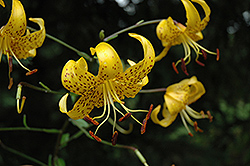It's all about ...
plants

Plant Height: 32 inches
Flower Height: 4 feet
Spacing: 24 inches
Sunlight:
![]()
![]()
Hardiness Zone: 3a
Other Names: Lilium pseudotigrinum
Description:
A lovely lily with striking yellow flowers with lots of burgundy freckles; with its upward, outward, and nodding blooms this plant has particular visual interest; an excellent choice for border plantings, a stunning impact when massed
Ornamental Features
Turk's Cap Lily features bold nodding yellow trumpet-shaped flowers with dark brown spots at the ends of the stems in mid summer. The flowers are excellent for cutting. Its narrow leaves remain green in colour throughout the season.
Landscape Attributes
Turk's Cap Lily is an herbaceous perennial with a rigidly upright and towering form. Its medium texture blends into the garden, but can always be balanced by a couple of finer or coarser plants for an effective composition.
This plant will require occasional maintenance and upkeep, and should be cut back in late fall in preparation for winter. Gardeners should be aware of the following characteristic(s) that may warrant special consideration;
- Insects
- Disease
Turk's Cap Lily is recommended for the following landscape applications;
- Mass Planting
- General Garden Use
Planting & Growing
Turk's Cap Lily will grow to be about 32 inches tall at maturity extending to 4 feet tall with the flowers, with a spread of 32 inches. When grown in masses or used as a bedding plant, individual plants should be spaced approximately 24 inches apart. It tends to be leggy, with a typical clearance of 1 foot from the ground, and should be underplanted with lower-growing perennials. The flower stalks can be weak and so it may require staking in exposed sites or excessively rich soils. It grows at a fast rate, and under ideal conditions can be expected to live for approximately 10 years. As an herbaceous perennial, this plant will usually die back to the crown each winter, and will regrow from the base each spring. Be careful not to disturb the crown in late winter when it may not be readily seen!
This plant does best in full sun to partial shade. It does best in average to evenly moist conditions, but will not tolerate standing water. It is not particular as to soil type or pH. It is somewhat tolerant of urban pollution. This species is not originally from North America. It can be propagated by multiplication of the underground bulbs.
